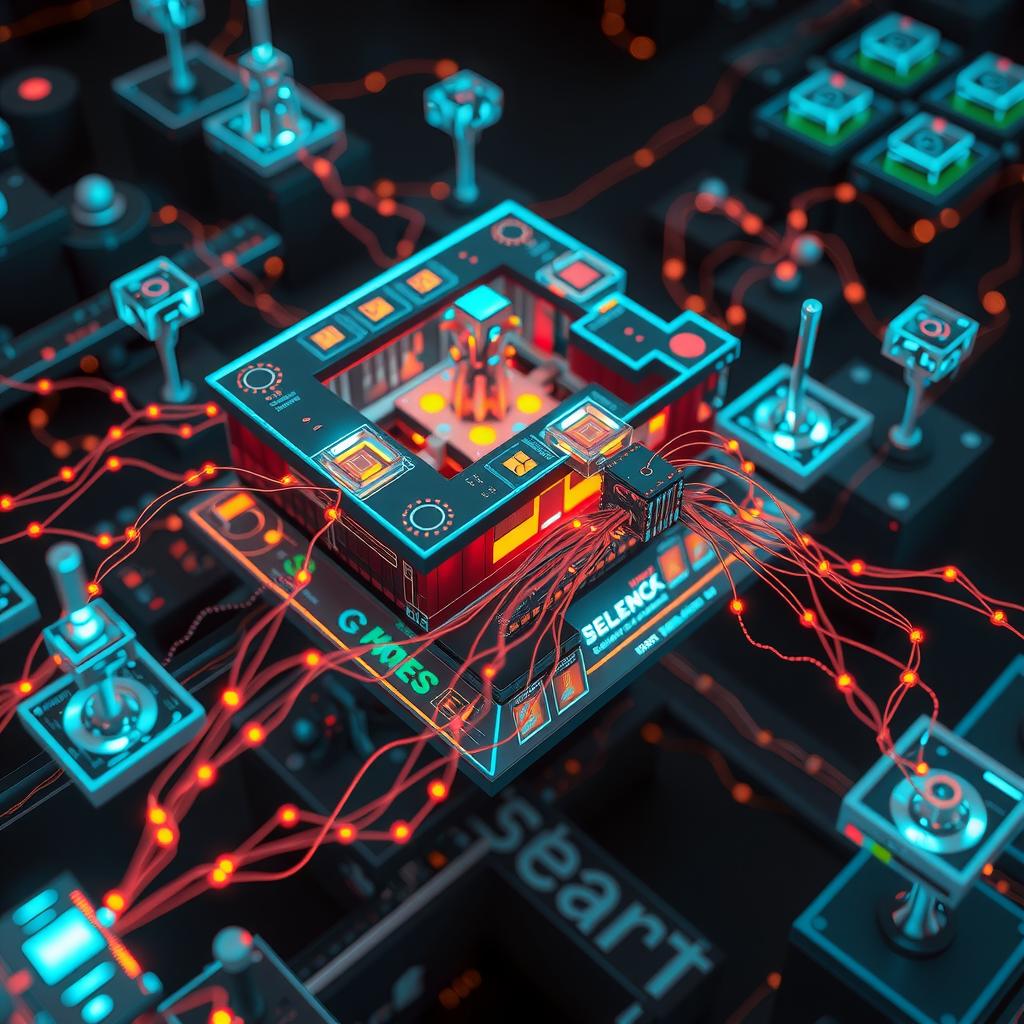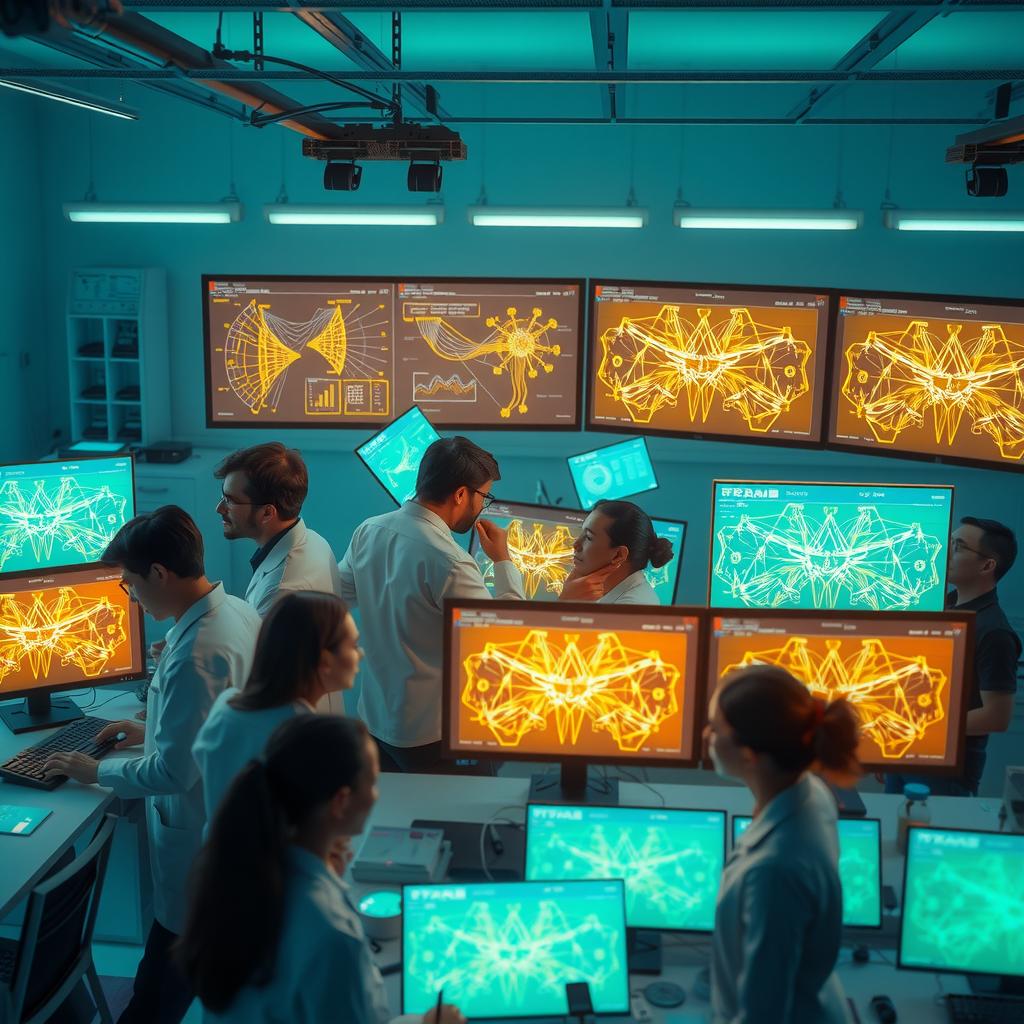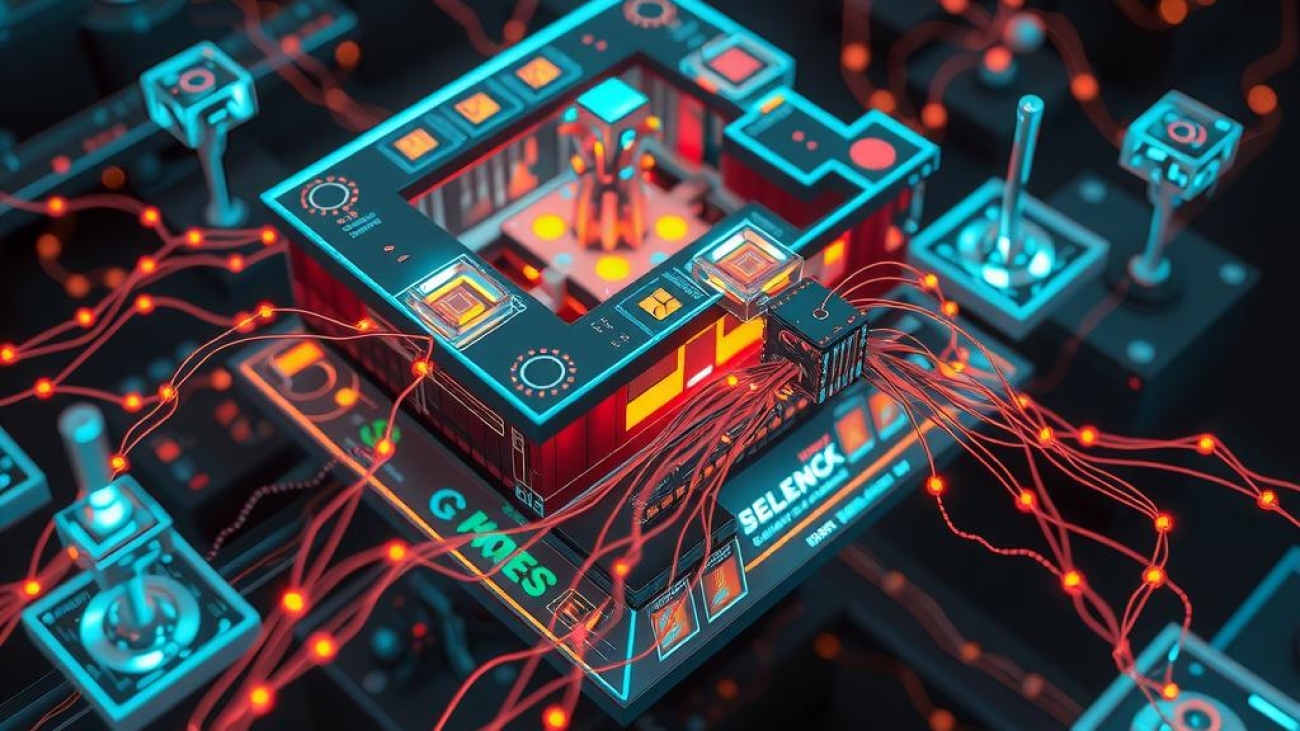Artificial intelligence (AI) has seen a remarkable surge in recent years, with Deep Learning Fundamentals playing a pivotal role in this advancement. At the heart of this transformative technology lies the neural network, a computational model inspired by the structure and function of the human brain. Through a series of interconnected layers, these neural networks possess the remarkable ability to learn and adapt, tackling complex problems with unprecedented accuracy and efficiency.
In the realm of Deep Learning Fundamentals, building neural networks from scratch is a fundamental skill that every aspiring AI enthusiast should possess. By understanding the inner workings of these networks, individuals can gain a deeper appreciation for the power of Artificial Intelligence and Machine Learning, and unlock new possibilities in fields such as Computer Vision, Natural Language Processing, and Robotics.
In this comprehensive guide, readers will embark on a journey to unravel the mysteries of Neural Networks, delving into the principles of Backpropagation, Gradient Descent, and Activation Functions. Through hands-on exploration, they will witness the emergence of Feedforward Networks and discover the optimization techniques that enable these models to excel in a variety of tasks.
Moreover, the article will explore the importance of Regularization methods, such as Dropout and Batch Normalization, which serve to enhance the generalization capabilities of Neural Networks and prevent overfitting. By understanding these fundamental concepts, readers will be well-equipped to design and implement their own Deep Learning models, paving the way for innovative solutions and groundbreaking discoveries.
The Deep Learning Fundamentals: Building Neural Networks from Scratch guide is not merely a theoretical exploration; it also delves into the practical applications of these techniques. Using the powerful Python programming language and the versatile NumPy library, readers will learn to translate their understanding into tangible code, harnessing the full potential of Neural Networks to tackle real-world problems.
Whether you are a student, a researcher, or a technology enthusiast, this comprehensive guide to Deep Learning Fundamentals will equip you with the knowledge and skills necessary to unlock the extraordinary potential of Artificial Intelligence and Machine Learning. Embark on this captivating journey and witness the transformation of your understanding as you build Neural Networks from the ground up.

Key points:
- Introduction to Artificial Neurons and the Perceptron Model: Delve into the fundamental building blocks of neural networks – artificial neurons, and explore the perceptron model, a foundational concept in neural network architecture.
- Activation Functions: Sigmoid, ReLU, and Variants: Examine the various activation functions, such as the sigmoid and ReLU, and understand their role in enabling non-linear transformations within neural networks.
- Feedforward Neural Networks: Architecture and Forward Propagation: Investigate the structure and design of feedforward neural networks, including the flow of information through the network during the forward propagation process.
- Loss Functions and Optimization in Neural Networks: Discuss the concept of loss functions and how they are used to measure the performance of neural networks, as well as the role of optimization techniques in minimizing these loss functions.
- Backpropagation Algorithm: The Backbone of Neural Network Training: Explore the backpropagation algorithm, the fundamental technique that enables efficient training of neural networks by propagating error signals backward through the network.

Unveiling the Secrets of Neural Network Architecture: A Hands-On Exploration
The Fundamentals of Neural Network Architecture
The foundation of any successful deep learning model lies in its underlying neural network architecture. In this detailed paragraph, we will delve into the core concepts that govern the structure and function of neural networks. We will explore the essential building blocks, such as the input layer, hidden layers, and output layer, and understand how they work in tandem to process and transform data. Additionally, we will examine the importance of activation functions, which play a crucial role in introducing non-linearity and enabling neural networks to learn complex patterns. The concept of feedforward networks will be discussed, highlighting their ability to propagate information in a unidirectional manner, laying the groundwork for more advanced architectures. This comprehensive exploration will provide you with a solid understanding of the fundamental principles that shape the architecture of neural networks, paving the way for your journey into the world of Deep Learning Fundamentals: Building Neural Networks from Scratch.
Optimization and Regularization Techniques
Optimizing the performance of neural networks is a critical aspect of the deep learning process. In this section, we will dive into the intricacies of optimization techniques, such as gradient descent and its variants, which enable neural networks to converge towards optimal solutions. We will also discuss the importance of regularization methods, including L1/L2 regularization, dropout, and batch normalization, which help to prevent overfitting and enhance the generalization capabilities of your models. Understanding these optimization and regularization strategies will empower you to fine-tune your Deep Learning Fundamentals models, ensuring their robustness and effectiveness in real-world applications.
Exploring Feedforward Neural Networks
Feedforward neural networks represent the foundational architecture in the world of deep learning. In this paragraph, we will delve into the inner workings of these networks, which are characterized by their ability to propagate information in a unidirectional manner, from the input layer through the hidden layers and ultimately to the output layer. We will explore the role of activation functions in introducing non-linearity and enabling these networks to model complex relationships within the data. Furthermore, we will discuss the process of backpropagation, which is the key algorithm that allows for efficient training of feedforward neural networks by propagating error gradients backwards through the layers. Mastering the intricacies of feedforward neural networks will equip you with a solid foundation to tackle more advanced architectures covered in the Deep Learning Fundamentals: Building Neural Networks from Scratch product.
Applications of Neural Networks in Computer Vision
Neural networks have revolutionized the field of computer vision, enabling remarkable advancements in tasks such as image classification, object detection, and semantic segmentation. In this section, we will explore how neural network architectures can be leveraged to tackle these computer vision challenges. We will discuss the convolutional neural network (CNN) architecture, which is particularly well-suited for processing and extracting features from image data. Additionally, we will delve into techniques like transfer learning and fine-tuning, which allow you to adapt pre-trained CNN models to specific computer vision tasks, leveraging the Deep Learning Fundamentals knowledge you’ve acquired. By understanding the applications of neural networks in computer vision, you will be equipped to tackle a wide range of real-world problems in areas such as autonomous vehicles, medical imaging, and beyond.
Neural Networks in Natural Language Processing
The power of neural networks extends beyond computer vision, and into the realm of natural language processing (NLP). In this paragraph, we will explore how neural network architectures can be applied to tasks such as text classification, language modeling, and sequence-to-sequence learning. We will discuss the recurrent neural network (RNN) architecture and its variants, including long short-term memory (LSTM) and gated recurrent units (GRUs), which are particularly well-suited for processing sequential data like text. Additionally, we will touch upon the attention mechanism, a powerful technique that enhances the performance of RNNs in NLP tasks. By understanding the capabilities of neural networks in natural language processing, you will be able to unleash their potential in a wide range of applications, from chatbots and language translation to sentiment analysis and text generation, all while leveraging the Deep Learning Fundamentals knowledge you’ve acquired.

From Neurons to Networks: Constructing the Building Blocks of Deep Learning
Unraveling the Complexity of Neural Networks
Deep Learning, a revolutionary field within the broader domain of Artificial Intelligence, has transformed the landscape of modern computing. At the heart of this paradigm shift lies the intricate network of interconnected neurons, which serve as the fundamental building blocks of deep learning models. In the context of Deep Learning Fundamentals: Building Neural Networks from Scratch, we delve into the intricate web of these neural connections, exploring how they are constructed, trained, and optimized to tackle complex problems across a vast array of applications.
The journey from individual neurons to expansive neural networks is a captivating one, driven by the principles of Backpropagation and Gradient Descent. These powerful algorithms enable the network to learn from data, adjusting the strength of the connections between neurons to minimize errors and improve performance. Through the strategic application of Activation Functions, Feedforward Networks, and advanced optimization techniques such as Regularization and Batch Normalization, deep learning models can navigate the intricacies of Machine Learning tasks, from Computer Vision to Natural Language Processing and beyond.
As we unravel the complexities of neural network architecture, we discover the critical role of Optimization in unlocking the full potential of these systems. The delicate interplay between hyperparameters, architectural choices, and training strategies is essential in crafting high-performing models that can tackle the most challenging problems. By mastering the fundamentals of Deep Learning Fundamentals: Building Neural Networks from Scratch, we equip ourselves with the necessary tools to design, train, and deploy robust and versatile deep learning solutions that push the boundaries of what’s possible in the realm of Artificial Intelligence and Robotics.
Navigating the Depths of Neural Network Design
The construction of deep learning models is a multifaceted endeavor, requiring a deep understanding of the underlying principles that govern the behavior of neural networks. As we delve into the Deep Learning Fundamentals: Building Neural Networks from Scratch, we discover the intricate relationships between the architectural components, training processes, and optimization techniques that collectively shape the performance of these powerful systems.
At the core of a neural network lies the interplay between Neurons and their interconnected Synapses. These fundamental building blocks, inspired by the biological nervous system, form the foundation upon which complex Neural Networks are built. Through the strategic arrangement of these elements and the application of Backpropagation and Gradient Descent, the network learns to extract meaningful features from data, ultimately enabling it to excel at a wide range of Machine Learning tasks.
As we explore the nuances of neural network design, we uncover the pivotal role of Activation Functions in introducing non-linearity and enabling the network to model complex, non-linear relationships. From the ubiquitous ReLU to more advanced functions like Sigmoid and Tanh, the choice of activation strategy can profoundly impact the network’s ability to learn and generalize.
Equally important is the architectural configuration of the network, with Feedforward Networks serving as the foundational structure. By stacking multiple layers of neurons, these networks can capture increasingly abstract representations of the input data, paving the way for powerful Deep Learning models. However, the journey does not end there, as techniques like Regularization and Batch Normalization play a crucial role in ensuring the network’s robustness and generalization capabilities.
Through a deep dive into the Deep Learning Fundamentals: Building Neural Networks from Scratch, we uncover the intricate interplay between the various components that shape the performance of neural networks. By mastering these fundamental principles, we equip ourselves with the necessary knowledge to design, train, and deploy Artificial Intelligence solutions that push the boundaries of what’s possible in Computer Vision, Natural Language Processing, Robotics, and beyond.
Optimizing Performance through Backpropagation and Gradient Descent
At the heart of Deep Learning Fundamentals: Building Neural Networks from Scratch lies the elegant and powerful optimization techniques of Backpropagation and Gradient Descent. These algorithms, which work in tandem, are responsible for the remarkable success and widespread adoption of deep learning models across a vast array of applications.
Backpropagation, the cornerstone of
“Activation Unleashed: Unlocking the Power of Nonlinear Transformations”
Harnessing the Extraordinary Capabilities of Nonlinear Activation Functions
In the realm of Deep Learning Fundamentals: Building Neural Networks from Scratch, the role of nonlinear activation functions cannot be overstated. These powerful mathematical transformations hold the key to unlocking the extraordinary capabilities of neural networks. By introducing nonlinearity into the model, activation functions enable neural networks to learn and represent complex, nonlinear relationships in the data, which is essential for tackling a wide range of artificial intelligence and machine learning challenges.
One of the most widely used activation functions in Deep Learning Fundamentals is the Rectified Linear Unit (ReLU). This simple yet highly effective function has become a staple in feedforward neural networks due to its ability to introduce sparsity, accelerate training, and facilitate the flow of gradients during backpropagation. The ReLU function’s piecewise linear nature allows it to capture nonlinearities while maintaining computational efficiency, making it a popular choice for optimization and regularization techniques such as Dropout and Batch Normalization.
Beyond the ReLU, Deep Learning Fundamentals explores a rich tapestry of other activation functions, each with its unique characteristics and applications. The Sigmoid and Tanh functions, for instance, are well-suited for binary classification and natural language processing tasks, where they can capture the probability of an output being within a specific range. Meanwhile, the Leaky ReLU and Parametric ReLU variants address the issue of “dying ReLU” by introducing a small, non-zero gradient for negative inputs, enabling more robust feature learning.
As researchers and practitioners delve deeper into the world of Deep Learning Fundamentals, the understanding and application of nonlinear activation functions continue to evolve. These transformations serve as the backbone of neural network architectures, empowering models to learn and generalize in remarkable ways. By mastering the principles of activation function selection and implementation, Deep Learning Fundamentals practitioners can unlock the true power of neural networks and push the boundaries of what is possible in the realms of computer vision, natural language processing, and robotics.
Exploring the Versatility of Activation Functions
In the realm of Deep Learning Fundamentals: Building Neural Networks from Scratch, the choice of activation functions plays a crucial role in determining the performance and capabilities of neural networks. These nonlinear transformations act as the building blocks for artificial intelligence and machine learning models, enabling them to learn and represent complex patterns in the data.
One of the most versatile activation functions in Deep Learning Fundamentals is the Sigmoid function. This S-shaped curve is particularly well-suited for binary classification tasks, where the output represents the probability of an input belonging to a specific class. The Sigmoid function’s ability to map any input to a value between 0 and 1 makes it a popular choice for natural language processing applications, such as sentiment analysis and text classification.
Another widely used activation function is the Tanh (Hyperbolic Tangent) function. Similar to the Sigmoid, the Tanh function maps its input to a range of [-1, 1], but with a steeper slope near the origin. This property makes Tanh well-suited for optimization and regularization techniques, as it can help neural networks learn more robust and stable representations.
Beyond the Sigmoid and Tanh, Deep Learning Fundamentals explores a vast array of other activation functions, each with its own unique characteristics and applications. The Leaky ReLU, for instance, addresses the issue of “dying ReLU” by introducing a small, non-zero gradient for negative inputs, enabling more efficient feature learning. The Parametric ReLU, on the other hand, takes this concept a step further by allowing the network to learn the optimal slope for negative inputs during training.
As researchers and practitioners delve deeper into the realm of Deep Learning Fundamentals, the understanding and application of activation functions continue to evolve. These nonlinear transformations are the foundation upon which neural network architectures are built, empowering models to learn and generalize in remarkable ways. By mastering the principles of activation function selection and implementation, Deep Learning Fundamentals enthusiasts can unlock the true potential of
Diving into Feedforward Neural Networks: Architecting the Flow of Information
The Essence of Feedforward Neural Networks
At the core of Deep Learning Fundamentals: Building Neural Networks from Scratch, feedforward neural networks stand as the foundational architecture for many powerful AI models. These networks, also known as multilayer perceptrons (MLPs), are designed to process information in a unidirectional manner, channeling it through a series of interconnected layers to produce desired outputs. By understanding the intricate flow of information within these networks, we can unlock the true potential of Deep Learning Fundamentals and harness the capabilities of artificial intelligence.
Feedforward neural networks are composed of multiple layers, each containing a set of interconnected nodes or neurons. The data enters the network through the input layer, where it undergoes a series of transformations as it passes through the hidden layers. Each hidden layer applies a nonlinear activation function to the weighted sum of its inputs, allowing the network to learn complex patterns and relationships within the data. The final output layer then produces the desired predictions or classifications.
One of the key aspects of feedforward networks is their ability to approximate any continuous function, given a sufficient number of hidden layers and neurons. This property, known as the Universal Approximation Theorem, underpins the versatility of these architectures in tackling a wide range of problems, from computer vision and natural language processing to robotics and beyond. By mastering the Deep Learning Fundamentals behind feedforward networks, practitioners can unleash the full potential of artificial intelligence and push the boundaries of what’s possible.
Optimizing Feedforward Networks: Backpropagation and Beyond
The success of Deep Learning Fundamentals: Building Neural Networks from Scratch lies in the optimization techniques employed to train feedforward neural networks. At the heart of this process is the backpropagation algorithm, a powerful method that efficiently propagates error gradients back through the network, enabling the weights and biases to be adjusted in a way that minimizes the overall loss.
Backpropagation, combined with the Gradient Descent optimization technique, allows feedforward networks to learn complex representations from data. By iteratively adjusting the network parameters in the direction of the negative gradient, the model can converge towards an optimal set of weights that minimize the error between the predicted outputs and the true labels. This iterative process is the foundation of the Deep Learning Fundamentals framework, enabling the network to learn and generalize effectively.
Beyond backpropagation, modern feedforward networks often incorporate additional techniques to enhance their performance and generalization capabilities. Techniques such as Regularization, Batch Normalization, and Dropout help to address issues like overfitting, improve training stability, and enhance the network’s ability to generalize to new, unseen data. By leveraging these advanced concepts within the Deep Learning Fundamentals ecosystem, practitioners can build highly effective and robust feedforward neural networks.
Architecting Feedforward Networks for Diverse Applications
The versatility of feedforward neural networks extends to their application across a wide range of domains, from Computer Vision and Natural Language Processing to Robotics and beyond. By thoughtfully designing the network architecture and leveraging the Deep Learning Fundamentals principles, practitioners can tailor these models to excel in specific tasks and unlock new possibilities in artificial intelligence.
In Computer Vision, for example, feedforward networks can be employed as the backbone of image classification, object detection, and image segmentation models. By stacking multiple hidden layers and incorporating specialized components like convolutional and pooling layers, these networks can learn powerful visual representations and make accurate predictions.
Similarly, in Natural Language Processing, feedforward networks can be utilized for tasks such as text classification, language modeling, and machine translation. By combining the network with techniques like word embeddings and attention mechanisms, practitioners can harness the power of Deep Learning Fundamentals to tackle complex linguistic problems.
Ultimately, the success of feedforward neural networks lies in their ability to adaptively learn from data and generalize to new scenarios. By mastering the Deep Learning Fundamentals: Building Neural Networks from Scratch, practitioners can unlock the full potential of these architectures and push the boundaries of what’s possible in the world of artificial intelligence.
Feedforward Networks in the Modern AI Landscape
As the field of Deep Learning Fundamentals continues to evolve, feedforward neural networks remain a crucial component of the modern AI landscape. These architectures serve as the foundation for more advanced models and techniques, constantly being refined and optimized to tackle increasingly complex problems
Optimization Unveiled: Minimizing Loss and Maximizing Performance
The Art of Balancing Efficiency and Effectiveness
In the realm of Deep Learning Fundamentals: Building Neural Networks from Scratch, optimization is a crucial element that determines the overall success and performance of Deep Learning models. Whether you’re working on Computer Vision, Natural Language Processing, or Robotics applications, the ability to effectively optimize your Neural Networks is paramount. This article delves into the intricacies of optimization, shedding light on the strategies and techniques that can help you minimize loss and maximize performance in your Deep Learning projects.
At the heart of Deep Learning Fundamentals lies the concept of Optimization, which is responsible for fine-tuning the Neural Network parameters to achieve the desired outputs. The two primary optimization techniques commonly employed in Deep Learning are Gradient Descent and Backpropagation. Gradient Descent is a method that iteratively adjusts the model’s parameters in the direction of the negative gradient of the loss function, while Backpropagation is the algorithm used to efficiently compute the gradients during the training process.
The choice of optimization algorithm can have a significant impact on the model’s performance. Gradient Descent variants, such as Stochastic Gradient Descent (SGD), Adam, and RMSProp, each have their own strengths and weaknesses, and the selection of the appropriate algorithm depends on the specific requirements of your Deep Learning task. These optimization techniques are the cornerstones of Deep Learning Fundamentals, enabling the efficient training of Feedforward Networks and other Neural Network architectures.
Beyond the optimization algorithms, Deep Learning Fundamentals also explores the role of Regularization techniques in improving the generalization capabilities of Neural Networks. Regularization methods, such as Dropout and Batch Normalization, help to prevent overfitting and enhance the model’s ability to perform well on unseen data. By incorporating these techniques into your Deep Learning workflow, you can strike a balance between model complexity and generalization, ensuring optimal performance.
The optimization process in Deep Learning Fundamentals is not a one-size-fits-all approach. Factors such as the complexity of the Neural Network architecture, the nature of the Machine Learning task, and the size and quality of the dataset all play a crucial role in determining the most effective optimization strategies. Deep Learning Fundamentals equips you with the knowledge and tools to navigate this landscape, empowering you to make informed decisions and optimize your Deep Learning models for maximum performance.
In conclusion, the Optimization component of Deep Learning Fundamentals: Building Neural Networks from Scratch is a fundamental aspect of Deep Learning that deserves careful attention. By mastering the art of Optimization, you can unlock the true potential of Deep Learning and elevate your Artificial Intelligence and Machine Learning projects to new heights of success.
“Backpropagation Demystified: The Backbone of Neural Network Training”
The Power of Backpropagation in Neural Network Learning
Backpropagation is the backbone of neural network training, serving as the fundamental algorithm that enables these powerful models to learn complex patterns from data. At the core of Deep Learning Fundamentals: Building Neural Networks from Scratch, this algorithm plays a crucial role in the optimization process, allowing neural networks to iteratively adjust their internal parameters to minimize the error between the predicted and desired outputs.
The backpropagation algorithm, which stands for “backward propagation of errors,” is a supervised learning technique that employs a gradient descent optimization method to update the weights and biases of a neural network. By computing the gradients of the loss function with respect to each parameter, the algorithm can efficiently propagate the error signals backward through the network, guiding the optimization process towards a more optimal solution.
The key steps in the backpropagation algorithm involve forward propagation, error calculation, and backward propagation. During the forward pass, the input data is passed through the network, and the output is calculated using the current parameter values. The error between the predicted output and the desired output is then computed using a loss function, such as mean squared error or cross-entropy. In the backward pass, the gradients of the loss function with respect to each parameter are calculated, and the parameters are updated accordingly using gradient descent or other optimization techniques.
One of the primary advantages of backpropagation is its ability to efficiently compute the gradients of the loss function with respect to all the parameters in the network, even for deep and complex neural architectures. This efficient gradient computation is achieved through the application of the chain rule, which allows the algorithm to propagate the error signals backward through the network layers, updating the parameters at each layer in a systematic manner.
The Deep Learning Fundamentals: Building Neural Networks from Scratch product provides a comprehensive understanding of the backpropagation algorithm and its implementation, enabling you to build and train your own neural networks from scratch. By delving into the mathematical foundations and practical applications of this powerful technique, you’ll gain the skills to tackle a wide range of machine learning and artificial intelligence problems, from computer vision and natural language processing to robotics and beyond.
The Backpropagation Algorithm: Mathematics and Intuition
The mathematical foundation of the backpropagation algorithm is rooted in calculus and optimization theory. The key concept behind backpropagation is the chain rule, which allows for the efficient computation of the gradients of the loss function with respect to each parameter in the network.
The chain rule states that the derivative of a composite function (such as the loss function in a neural network) can be expressed as the product of the derivatives of the individual functions that compose it. This property is leveraged in the backpropagation algorithm to propagate the error signals backward through the network, updating the parameters at each layer based on their contribution to the overall loss.
Intuitively, the backpropagation algorithm can be understood as a way to efficiently distribute the error signal throughout the network, allowing each parameter to “learn” from the mistakes made in the prediction. By following the gradients of the loss function, the parameters are updated in a direction that reduces the overall error, effectively optimizing the network’s performance.
The Deep Learning Fundamentals: Building Neural Networks from Scratch product delves into the mathematical details of the backpropagation algorithm, providing a thorough understanding of the underlying concepts and their practical implementation. Through a combination of theoretical explanations and hands-on exercises, you’ll master the techniques required to train neural networks using this powerful algorithm.
Backpropagation in Practice: Optimization and Regularization
While the backpropagation algorithm forms the backbone of neural network training, there are several additional techniques and strategies that can be employed to enhance the performance and generalization capabilities of neural networks.
One such technique is optimization, which involves the selection of appropriate optimization algorithms, such as gradient descent, Adam, or RMSProp, to efficiently update the network parameters during the training process. The Deep Learning Fundamentals: Building Neural Networks from Scratch product explores various optimization methods and their impact on the convergence and performance of neural networks.
Another important aspect is regularization, which helps to prevent neural networks from overfitting the training data and ensures better generalization to
“Gradient Descent Unraveled: Navigating the Path to Optimal Solutions”
Unlocking the Secrets of Gradient Descent
Gradient descent is a fundamental optimization algorithm at the heart of modern machine learning and artificial intelligence. This powerful technique has enabled the remarkable advancements we’ve witnessed in fields such as computer vision, natural language processing, and robotics. In the context of Deep Learning Fundamentals: Building Neural Networks from Scratch, understanding the intricacies of gradient descent is crucial for effectively training and optimizing neural networks.
The success of Deep Learning Fundamentals lies in its ability to guide readers through the complexities of gradient descent, equipping them with the knowledge and tools necessary to navigate the path to optimal solutions. This comprehensive guide delves into the inner workings of gradient descent, exploring its mathematical foundations and practical applications.
Navigating the Landscape of Optimization
At the core of gradient descent is the concept of minimizing a cost or loss function by iteratively adjusting the model parameters in the direction of the negative gradient. This process involves computing the gradients of the cost function with respect to the model parameters and using them to update the parameters in a way that reduces the overall loss. However, the journey to optimal solutions is not without its challenges.
The Deep Learning Fundamentals curriculum delves into the nuances of gradient descent, addressing common pitfalls and providing strategies to overcome them. From understanding the role of learning rates and momentum, to exploring techniques like batch normalization and regularization, this guide empowers readers to make informed decisions and achieve optimal performance in their neural network models.
Mastering the Art of Gradient Descent
The Deep Learning Fundamentals approach to gradient descent goes beyond mere theory, offering practical insights and hands-on exercises to solidify the understanding of this fundamental concept. Readers will explore various optimization algorithms, such as stochastic gradient descent and Adam, and learn how to implement them using Python and NumPy.
By mastering the art of gradient descent, readers of Deep Learning Fundamentals will be equipped to tackle a wide range of machine learning and artificial intelligence problems. From computer vision applications to natural language processing tasks, the principles and techniques learned here will serve as a strong foundation for building robust and efficient neural network models.
Unveiling the Secrets of Neural Network Architecture: A Hands-On Exploration
Deep learning has revolutionized artificial intelligence in recent years, enabling breakthroughs in various domains such as computer vision, natural language processing, and robotics. This article aims to provide a comprehensive introduction to the core concepts of deep learning by guiding readers through the process of building a neural network from the ground up.
Key Points:
- Introduction to artificial neurons and the perceptron model
- Activation functions: sigmoid, ReLU, and their variants
- Feedforward neural networks: architecture and forward propagation
- Loss functions and the concept of optimization in neural networks
- Backpropagation algorithm: the backbone of neural network training
- Gradient descent and its variations (e.g., stochastic gradient descent)
- Implementing a simple neural network in Python using NumPy
- Training the network on a basic dataset (e.g., MNIST for digit recognition)
- Techniques for improving network performance: regularization, dropout, batch normalization
- Introduction to deep learning frameworks (TensorFlow, PyTorch) for comparison
FAQ:
Q: What is the perceptron model, and how does it relate to artificial neurons?
A: The perceptron model is the fundamental building block of artificial neural networks. It is a simplified mathematical model of a biological neuron, where the inputs are weighted, summed, and passed through an activation function to produce an output.
Q: What are the commonly used activation functions in neural networks, and how do they differ?
A: The most commonly used activation functions are the sigmoid function, the rectified linear unit (ReLU), and their variants. The sigmoid function outputs a value between 0 and 1, while the ReLU function outputs the input value if it is positive and 0 otherwise. Each activation function has its own advantages and is suitable for different types of problems.
Q: How does the backpropagation algorithm work, and why is it considered the backbone of neural network training?
A: The backpropagation algorithm is a supervised learning technique that allows neural networks to learn by iteratively adjusting the weights of the connections between neurons. It works by propagating the error from the output layer back through the network, computing the gradients of the loss function with respect to the weights, and then updating the weights to minimize the loss.
Q: What are some techniques for improving the performance of neural networks, and how do they work?
A: Techniques for improving neural network performance include regularization, dropout, and batch normalization. Regularization helps prevent overfitting by adding a penalty term to the loss function. Dropout randomly deactivates a subset of neurons during training, which helps the network learn more robust features. Batch normalization standardizes the inputs to each layer, which can improve the stability and performance of the network.
Q: How do deep learning frameworks like TensorFlow and PyTorch compare, and what are their key features?
A: TensorFlow and PyTorch are two of the most popular deep learning frameworks. TensorFlow is known for its robust ecosystem, scalability, and production-ready deployment, while PyTorch is favored for its flexibility, dynamic computation graphs, and ease of use for research and experimentation. Both frameworks provide powerful tools for building, training, and deploying neural networks, but their strengths and use cases may differ depending on the specific requirements of the project.
More posts















